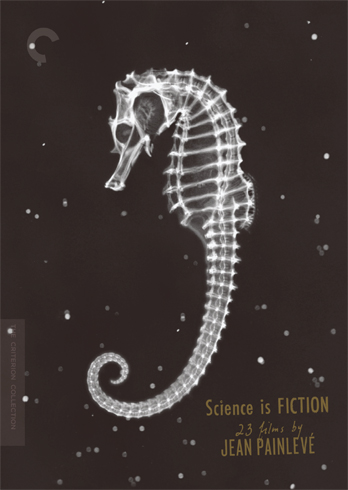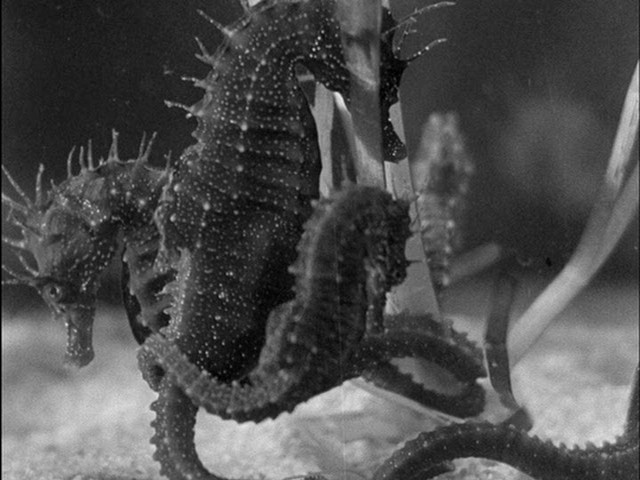
Image Credit: Criterion Collection
Riffing on Anne’s recent post, I’d like to highlight a film collection that defies left-brain/right-brain categorization. The Criterion Collection recently released Science is Fiction, a three-disc anthology of French filmmaker Jean Painlevé’s body of work, which spanned the 1920s through the 1980s. With titles like “The Love Life of the Octopus” and “Freshwater Assassins,” as well as a 21st-century soundtrack by Yo La Tengo, Painlevé’s short films challenge any didactic, formulaic, or downright schlumpy associations of the Nature Film.
In an interview, Ira Kaplan of Yo La Tengo notes that “a lot of [Painlevé’s work] seems like compelling abstract art—which happens to be done with fish.” However, Kaplan’s interpretation is needlessly limiting: what’s brilliant about Painlevé’s films is precisely that one can find so many levels of information and points of engagement, as he merges the artist's and naturalist’s vision.
For instance, while “The Sea Horse” (1933) contains visual puns, like a race-track scene juxtaposed with sea-horse footage, it also demonstrates Painlevé’s sensitivity to the medium’s potential for communicating scientific information. Microscopy allows us to get a feel for the subject via different levels of scale, immersing us in the sea horse's magnified world; accelerated footage lets us watch the development of a sea-horse embryo unfolding at over a thousand times the normal rate.
Social commentary also has its place in Painlevé's work. Quoting an interview with Painlevé, Scott MacDonald notes that Painlevé chose the sea horse as a subject in part for its "progressive gender politics," with the male and female collaborating in child birth. The film lingers on the male sea-horse as he gives birth—zooming in on his rolling eyes, noting his sped-up breathing, following his painful convulsions. He releases only a few babies at a time, which (Painlevé announces with some glee) means the contractions go on for several hours. As MacDonald explains, "He wants us to learn not only about but from this strange fish.”

Image Credit: Screen capture from Science is Fiction
Yo La Tengo's The Sounds of Science, commissioned by the San Francisco Film Festival in 2001 to accompany eight classic Painlevé films, is offered alongside the originals. The sonic information does affect our interpretation of the footage: for example, in "Love Life" (1967), Yo La Tengo's gnarly electric guitars make the sexual encounter between two octopi aggressive, frenetic, violent, whereas the trippy electronic music selected by Painlevé creates a kinkier vibe, calling attention to his sly narration: “The male has to insert the end of his special arm, the third to the right of his head, into the female’s respiratory category.” Pause. "There is no officially sanctioned position for doing that.”
However, this update works because (a) The Sounds of Science literally rocks, offering a modern entry point into Painlevé’s films and (b) Painlevé himself was all about the remix: he made three versions of each film, for academic study, for the scientific community, and for general audiences. In addition to shortening the films, he also “edited them to jazz, big band, and electronic soundtracks.”
Science is Fiction suggests that, in going back to the early nature film, we can re-discover its imaginative potential. What makes this compelling filmmaking is precisely Painlevé's unfettered embrace of the figurative's role in science. Science is Fiction is a fitting title not because we need to read Painlevé's science films only as avant-garde aesthetic fantasies or, more generally, to flatly reduce science to discourse. In each film, we see Painlevé responding creatively, fitting his aesthetic style to the particularities of each organism, educating us about the creature's life cycle or mating habits without denying the human and cultural perspective that also guides our vision of its otherness. For instance, in "The Vampire" (1945), shot to a throaty jazz tune and incorporating images from Nosferatu (1922), the Brazilian vampire bat also becomes a figure for the menace of Nazism. These films pre-figure Donna Haraway's lesson that “There is no border where evolution ends and history begins, where genes stop and environment takes up, where culture rules and nature submits...”
Comments
Artist and naturalist merged
Thank you so much for introducing me to Painlevé! Watching just the clip on the link you included, I'm thrilled by the incredibly beautiful, artistic forms of the octopi. I've already informed my family that the set would make a most clever Christmas gift!
I love the idea in your post that there is no divide between art and science, as exemplified by Painlevé’s merging of "the artist's and naturalist’s vision." You write that in "going back to the early nature film, we can re-discover its imaginative potential," that in "each film, we see Painlevé responding creatively, fitting his aesthetic style to the particularities of each organism..." During my time in academia, while working on my Russian history Ph. D., I experienced visually everything I was learning. The sweep of Russian history, the geographic and sociological reasons why Russia remained autocratic for centuries, and so on - all this seemed like exhilerating, powerful esthetic material to me. Nothing else could beat it as the subject of art, it seems to me!
By the way, Ira Kaplan of Yo La Tengo, whom you quote (“a lot of [Painlevé’s work] seems like compelling abstract art—which happens to be done with fish”), is the son-in-law of Faith and John Hubley, the multiple Oscar-winning animation creators of many groundbreaking art animation films. Ira is the brother-in-law of Emily Hubley, also an independent animation artist who among many short films made one of my all-time favorites, "Enough." Yo La Tengo does the music for many of Emily's shorts. (I knew both Faith and Emily during my active years in the world of independent animation in NY.)